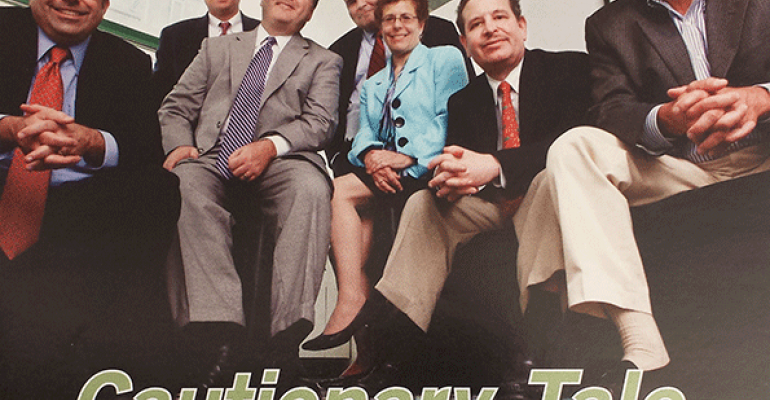The fortunes of the food retailing industry have varied wildly since 1996, when six analysts gathered at SN’s offices for the first annual Financial Analysts Roundtable.
But then, what hasn’t changed? Half of the banks represented by analysts in 1996 exist today only in memory, or as brand names within larger entities. SN’s offices have moved four times since then. The largest food retailing company on SN’s Top 75 list in 1996 was Kroger, with $23.7 billion in sales. Wal-Mart Stores, behind a steady Supercenter rollout, was fifth largest, at $16.3 billion. Today, Walmart has overtaken the top spot and grown food sales by more than 1,200% since 1996. No slouch itself, Kroger is No. 2 with $108.5 billion in annual sales, having increased sales by 357.8% since 1996.
The period included a punishing recession, and various threats from Internet grocers, alternative formats, foreign invaders, bankruptcies, mergers, and takeovers. Concurrent trends toward value and health in the meantime have upended the food industry, giving rise to retailers like Whole Foods and Sprouts on one side, and Aldi on the other. Analysts at times praised retailers for their foresight, chided them for their foibles and chronicled how they’ve adjusted to two tumultuous decades.
In honor of the 20th annual event, SN looked back at the first 19 discussions, presented in the below capsule reviews. These are being published in a series leading up to SN’s coverage of this year’s event, which took place last month.
2011
 The economy continued to struggle, particularly with regards to employment figures, leading analysts to predict retailers could turn to price wars or consolidation.
The economy continued to struggle, particularly with regards to employment figures, leading analysts to predict retailers could turn to price wars or consolidation.
“If the economy doesn't improve, the consumer will be in worse shape next year, and rationality may not prevail,” one analyst noted during the 2011 roundtable.
While Kroger continued to grow sales, retailers including Winn-Dixie, A&P and Supervalu were encountering increasing troubles. Even Walmart was losing shoppers to smaller, cheaper, more convenient vehicles and food retailers with strong promotional programs.
“Wal-Mart is stuck in a box — a very small box — and it's made of iron, which makes it hard to get out,” one analyst said.
2012
 While the irrational pricing and consolidation analysts predicted in 2011 didn’t fully materialize, conditions were every bit as bad as they feared, and not only for supermarkets.
While the irrational pricing and consolidation analysts predicted in 2011 didn’t fully materialize, conditions were every bit as bad as they feared, and not only for supermarkets.
Said one analyst during the 2012 roundtable, “people are buying less of everything.”
Everything, that is, but produce, which thanks to low prices and an emerging healthy eating trend was beginning to show signs of life.
Woes continued at Supervalu, which would shortly result in a deal to sell its assets to the same private-equity-and-real-estate consortium that it partnered with in 2006 to acquire Albertsons.
2013
 Five years since the onset of the great recession, and analysts and food retailers were still awaiting things to get “back to normal.”
Five years since the onset of the great recession, and analysts and food retailers were still awaiting things to get “back to normal.”
But a lower cost of capital helped to refire consolidation as one means to grow, led by Kroger’s move to capture Harris Teeter.
“It’s like the nuclear bombs have dropped, and the industry is rebuilding as much as it can,” one analyst said during the 2013 roundtable, “so consolidation is definitely a defensive reaction, mainly by the survivors.”
Safeway, beset by pricing perceptions and falling margins, sold off its lucrative Canada division and faced the prospect of renewal under new CEO Robert Edwards.
“We believe he is up to the challenge,” one analyst predicted, “but if an asset can’t be fixed, I think he will sell it.”
2014
 Sure enough, Safeway found a sale to be the best route, announcing a combination with the Cerberus-Albertsons group.
Sure enough, Safeway found a sale to be the best route, announcing a combination with the Cerberus-Albertsons group.
The deal would leave Kroger as the only survivor of the “Big 3” publicly traded supermarkets followed by analysts in 1996. Kroger by now was determined to pump its earnings muscle and was pursuing new initiatives including a move to e-commerce and a fast-growing natural/organic business.
“Kroger has momentum, which is pretty amazing in this industry,” one analyst marveled.
The combined impact of alternative formats – particularly those with a strong price offering – continued to weigh on overall results, analysts noted.
“If you look at who disrupts the market, it started with Walmart, then warehouse stores expanded, then dollar [stores] expanded, the high-end expanded and now perhaps it’s e-commerce,” one analyst said. “[Some] people might say [Aldi] is just a small box and it can’t possibly matter because it’s only doing a 1% or 2% share. But if you take 1% share away from a supermarket, you’re wiping out 6% to 8% of EBITDA.”





